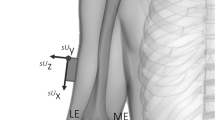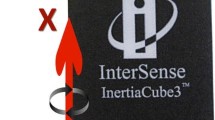Abstract
Inertial and magnetic measurement systems (IMMSs) are a new generation of motion analysis systems which may diffuse the measurement of upper-limb kinematics to ambulatory settings. Based on the MT9B IMMS (Xsens Technologies, NL), we therefore developed a protocol that measures the scapulothoracic, humerothoracic and elbow 3D kinematics. To preliminarily evaluate the protocol, a 23-year-old subject performed six tasks involving shoulder and elbow single-joint-angle movements. Criteria for protocol validity were limited cross-talk with the other joint-angles during each task; scapulohumeral-rhythm close to literature results; and constant carrying-angle. To assess the accuracy of the MT9B when measuring the upper-limb kinematics through the protocol, we compared the MT9B estimations during the six tasks, plus other four, with the estimations of an optoelectronic system (the gold standard), in terms of RMS error, correlation coefficient (r), and the amplitude ratio (m). Results indicate that the criteria for protocol validity were met for all tasks. For the joint angles mainly involved in each movement, the MT9B estimations presented RMS errors <3.6°, r > 0.99 and 0.9 < m < 1.09. It appears therefore that (1) the protocol in combination with the MT9B is valid for, and (2) the MT9B in combination with the protocol is accurate when, measuring shoulder and elbow kinematics, during the tasks tested, in ambulatory settings.







Similar content being viewed by others
References
Anglin C, Wyss UP (2000) Review of arm motion analyses. Proc Inst Mech Eng [H] 214:541–555
Bachmann ER, McGhee RB, Yun X, Zyda MJ (2001) Inertial and magnetic posture tracking for inserting humans into networked virtual environment. In: Proceedings of the ACM symp virtual reality software and technology, pp 9–16
Best R, Begg R (2006) Overview of motion analysis and gait feature. In: Begg R, Palaniswami M (eds) Computational intelligence for movement sciences. IGP pp 1–69, Hershey, Pennsylviania, USA
Biryukova EV, Roby-Brami A, Frolov AA, Mokhtari M (2000) Kinematics of human arm reconstructed from spatial tracking system recordings. J Biomech 33:985–995
Coley B, Jolles BM, Farron A, Bourgeois A, Nussbaumer F, Pichonnaz C, Aminian K (2006) Outcome evaluation in shoulder surgery using 3D kinematics sensors. Gait Posture. doi:10.1016/j.gaitpost.2006.06.016
Cutti AG, Paolini G, Troncossi M, Cappello A, Davalli A (2005) Soft tissue artefact assessment in humeral axial rotation. Gait Posture 21:341–349
Cutti AG, Garofalo P, Davalli A (2006) How accurate is the estimation of elbow kinematics using ISB recommended joint coordinate systems? Gait Posture 24:S36–S37
Cutti AG, Raggi M, Davalli A, Cappello A (2006) Definition of two reference elbow models from cadaver data. Gait Posture 24:S224–S225
Cutti AG, Cappello A, Davalli A (2006) In-vivo validation of a new technique for soft tissue artefact compensation at the upper-arm: preliminary results. Clin Biomech (Bristol, Avon) 21:S13–S19
Cutti AG, Giovanardi A, Rocchi L, Davalli A (2006) A simple test to assess the static and dynamic accuracy of an inertial sensors system for human movement analysis. In: Proceedings of the 28th IEEE EMBS annual international conference SaEP61, pp 5912–5915
Karduna AR, McClure PW, Michener LA, Sennett B (2001) Dynamic measurements of three-dimensional scapular kinematics: a validation study. J Biomech Eng 123:184–190
Lockard M (2006) Clinical biomechanics of the elbow. J Hand Ther 19:72–80
Ludewig PM, Cook TM (2000) Alterations in shoulder kinematics and associated muscle activity in people with symptoms of shoulder impingement. Phys Ther 80:276–291
Luinge HJ, Veltink PH, Baten CT (2007) Ambulatory measurement of arm orientation. J Biomech 40:78–85
McClure PW, Michener LA, Sennett BJ, Karduna AR (2001) Direct 3-dimensional measurement of scapular kinematics during dynamic movements in vivo. J Shoulder Elbow Surg 10:269–277
McClure PW, Michener LA, Karduna AR (2006) Shoulder function and 3-dimensional scapular kinematics in people with and without shoulder impingement syndrome. Phys Ther 86:1075–1090
Mell AG, LaScalza S, Guffey P, Ray J, Maciejewski M, Carpenter JE, Hughes RE (2005) Effect of rotator cuff pathology on shoulder rhythm. J Shoulder Elbow Surg 14:58S–64S
Meskers CG, Koppe PA, Konijnenbelt MH, Veeger DH, Janssen TW (2005) Kinematic alterations in the ipsilateral shoulder of patients with hemiplegia due to stroke. Am J Phys Med Rehabil 84:97–105
Park FC, Martin BJ (1994) Robot sensor calibration: solving AX = XB on the Euclidean group. IEEE Trans Rob Autom 10(5):717–721
Pascoal AG, van der Helm FF, Pezarat CP, Carita I (2000) Effects of different arm external loads on the scapulo-humeral rhythm. Clin Biomech (Bristol, Avon) 15(Suppl 1):S21–S24
Roetenberg D (2006) Inertial and magnetic sensing of human motion. Ph.D. thesis, Twente University
Sabatini AM (2006) Inertial sensing in biomechanics: a survey of computational techniques bridging motion analysis and personal navigation. In: Begg R, Palaniswami M (eds) Computational intelligence for movement sciences. IGP pp 70–100, Hershey, Pennsylviania, USA
Schmidt R, Disselhorst-Klug C, Silny J, Rau G (1999) A marker-based measurement procedure for unconstrained wrist and elbow motions. J Biomech 32:615–621
Sciavicco L, Siciliano B (2000) Modelling and control of robot manipulators. Springer-Verlag, New York
Steenbrink F, de Groot JH, Veeger HE, Meskers CG, van de Sande MA, Rozing PM (2006) Pathological muscle activation patterns in patients with massive rotator cuff tears, with and without subacromial anaesthetics. Man Ther 11:231–237
Stokdijk M, Biegstraaten M, Ormel W, de Boer YA, Veeger HE, Rozing PM (2000) Determining the optimal flexion-extension axis of the elbow in vivo—a study of interobserver and intraobserver reliability. J Biomech 33:1139–1145
Stokdijk M, Nagels J, Garling EH, Rozing PM (2003) The kinematic elbow axis as a parameter to evaluate total elbow replacement: a cadaver study of the iBP elbow system. J Shoulder Elbow Surg 12:63–68
Veeger HE, Yu B, An KN, Rozendal RH (1997) Parameters for modelling the upper extremity. J Biomech 30:647–652
Woltring HJ (1990) Data processing and error analysis. In: Cappozzo A, Berme N (eds) Biomechanics of human movement. Bertec Corporation, pp 203–237, Worthington, Ohio, USA
Wu G, van der Helm FC, Veeger HEJ, Makhsous M, van Roy P, Anglin C, Nagels J, Karduna A, McQuade K, Wang X, Werner FW, Buchholz B (2005) ISB recommendation on definitions of joint coordinate systems of various joints for the reporting of human joint motion—part II: shoulder, elbow, wrist and hand. J Biomech 38:981–992
Zhou H, Hu H, Tao Y (2006) Inertial measurements of upper limb motion. Med Biol Eng Comput 44:479–87
Zhou H, Stone T, Hu H, Harris N (2007) Use of multiple wearable inertial sensors in upper-limb motion tracking. Med Eng Phys. doi:10.1016/j.medengphy.2006.11.010
Acknowledgments
This work was supported by Regione Emilia-Romagna, in the framework of the Starter Project, PRRIITT—Misura 3.4 Azione A.
Author information
Authors and Affiliations
Corresponding author
Rights and permissions
About this article
Cite this article
Cutti, A.G., Giovanardi, A., Rocchi, L. et al. Ambulatory measurement of shoulder and elbow kinematics through inertial and magnetic sensors. Med Bio Eng Comput 46, 169–178 (2008). https://doi.org/10.1007/s11517-007-0296-5
Received:
Accepted:
Published:
Issue Date:
DOI: https://doi.org/10.1007/s11517-007-0296-5




